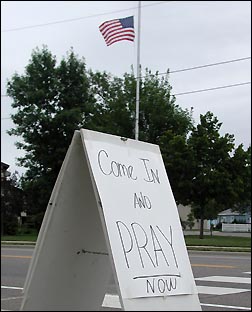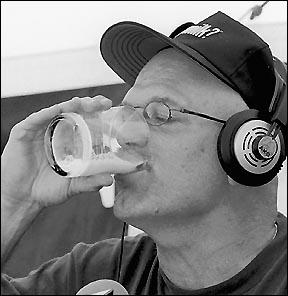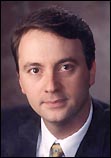The Year in Review
 PAHCS keeps expanding
PAHCS keeps expanding
Construction began on a $7.4 million remodeling project at the Paynesville Area Health Care System in May. The project includes a new emergency wing and ambulance entrance at the hospital (which is nearing completion now); an addition at the Paynesville Area Medical Clinic; a new dining room, an additional tub room, and updated bathrooms at the Koronis Manor; extensive mechanical and infrastructure improvements, especially in the Manor; and another addition for new maintenance and meeting rooms that will enable the outreach clinic to expand by taking the old maintenance and laundry areas.
A sign outside Grace United Methodist Church offered passersby on Highway 23 a place to pray after the terrorist attack in New York City and Washington, D.C., on Tuesday, Sept. 11.
The entire project - which involves a complicated schedule to keep the health care system functioning 24 hours a day, seven days a week - was expected to take 18 months, but an unusual default on a contact by a plumbing company from St. Cloud stopped the project for two weeks, and the project is now two months behind schedule.
The initial work on the project focused on three new additions: the new ER wing, the clinic addition, and a dining room addition at the Koronis Manor. Interior remodeling started at PAHCS in August, and in November the emergency entrance to the hospital was switched to the new wing.
PAHCS has also been busy examining its expansion options in long-term care, which the industry says is in a crisis state throughout the state. Minnesota has an excess of nursing home beds, while patients are using more and more stay-at-home options these days, leaving facilities with empty beds.
In October, PAHCS's possible purchase of the Good Samaritan Care Center in Paynesville and the Hilltop Good Samaritan Center in Watkins was announced. PAHCS, which turned a $400,000 profit in its 2001 fiscal year despite its losses in long-term care - is still negotiating a final purchase agreement with the Good Samaritan Society. If the deal goes through, PAHCS will have more than 450 employees and 175 nursing beds. PAHCS is planning to do a long-term care study about the needs of the area, including the desirability of assisted living, but it may decertify some of its beds in order to finish improvements at the Koronis Manor.
Another $3.2 million in improvements was planned at the Koronis Manor but could not be undertaken in the current project because of a state moratorium on nursing bed construction. If an exception is approved for PAHCS in 2002, the nursing home could be updated with more private rooms, more lounges, more private bathrooms, and more amenities.
School district's budget woes
Unfortunately, the school district's finances were in the headlines throughout the year.
In February, the school board of District #741 approved $512,000 in cuts for the 2001-02 school budget, culminating a three-month process to reduce the budget. The 2000-01 school year was the fourth consecutive year the school operated on a deficit budget. Even with the reductions, a deficit budget is proposed for 2001-02.
The district's annual audit, completed in October, revealed that the district should qualify for statutory operating debt, meaning it will have to submit a plan to the state to show how it will right its financial situation. The audit showed that the district had $57,000 in its general fund as of June 30, 2000, but this balance includes reserved funds (like staff development, compensatory revenue, and capital improvements). The balance of unreserved funds was in deficit by $243,000.
School officials appealed to voters for help, through an excess levy, which they described as an operating levy because it was so needed. District voters had approved a ten-year levy back in 1997, but due to a legislative change this was taken from the tax rolls and replaced with state aid. The identical $315 per pupil unit excess levy proposal aimed to reinstate the local taxes and produce an additional $475,000 in revenue for 2002-03, which would have helped balance the general fund budget and rebuild its reserves.
The levy proposal was voted down by district voters in November by a vote of 687-886. The 1,577 voters were the most at a school district election since 1990, when the new middle school and elementary school remodeling was approved by 1,919 voters. It was the first school referendum to be defeated since 1987.
Also on the November ballot were nine candidates for the school board, vying for four open spots. This was the most candidates since 11 ran in 1981 and the first time in a decade that the election was truly contested. Incumbent Deb Glenz and newcomers Mark Dingmann, Allen Schmidt, and Tami Stanger were elected to the board. Dingmann, Schmidt, and Stanger take office in January 2002.
The school board tried to have another levy referendum in December - in order to get a levy approved in time to get the revenue in 2002-03 and avoid more major cuts - but this idea was rejected by the state. Instead, another round of budget cuts for 2002-03 was started.
Weather extremes hit area
 A number of extremes concerning the weather affected the Paynesville area in 2001, starting with a cold spell a year ago. The weather wasn't really unusual, but it combined with low natural gas and propane supplies to hit homeowners with rapidly rising energy prices.
A number of extremes concerning the weather affected the Paynesville area in 2001, starting with a cold spell a year ago. The weather wasn't really unusual, but it combined with low natural gas and propane supplies to hit homeowners with rapidly rising energy prices.
Nearly two feet of snow got dumped on the Paynesville area in late November. The snow was so wet and heavy that it took 26 hours to clean the downtown streets, instead of the usual four hours.
Then spring came slowly, leaving snow drifts around town, fields blanketed with snow, and ice on Lake Koronis until April 21. In the span of a week, the rain melted most of the ice on the lake and the remaining snow and flooded the North Fork of the Crow River. The flooding along the river reached places, including Kandiyohi County Road 6, that water hadn't reached in 25 years. The water in the river led to flooding in low areas around Rice Lake and Lake Koronis, too.
The wet spring led to delays in planting, but the rain stopped rather abruptly in early June. By the end of July, farmers were praying for rain and worrying that their crops were wilting under the sun. In early August, a couple record temperatures were recorded in the St. Cloud area, according to meteorologist Bob Weisman of St. Cloud State University. Harvest in 2001 was much slower than under the more ideal conditions in 2000.
Finally, in late November, a winter storm dropped two feet of snow on the area, one of the heaviest snowfalls ever. But the storm didn't really mark the start of winter, as mild temperatures melted most of the snow except where it had been piled. Minnesota had 55 days of above normal temperatures this fall, which helped melt all the snow that arrived in November.
New airport faces opposition
A proposed new airport west of Paynesville took steps towards construction in 2001 amid controversy. In February, the school board passed a resolution opposing the zoning for the new airport because of concerns that it would limit the school's development options for the southern portion of its property, including the driving range, which the school owns but has leased to the golf course. When a compromise solution could not be reached, the zoning was passed by the airport zoning board in late March.
In April, the city of Paynesville and Paynesville Township revised their agreement for the project, establishing a maximum cost to the township of $200,000. MnDOT's Department of Aeronautics will pay for roughly 60 percent of the new airport, leaving the city and township to pay 40 percent together. Originally, they were going to split that cost, but now the township's portion has been limited to $200,000. Both entities have reserve funds to pay for their share of the new airport.
The airport project then moved to the land acquisition stage, which has taken longer than planned. The appraisals were done, presented to landowners, and then revised. Negotiations with the owners of the 210 acres needed for the airport started in the fall, but as the year ended the Paynesville Regional Airport Commission still did not own any land. In December, the commission approved sending resolutions asking the city and township to approve the acquisition of land, including by eminent domain if needed.
Master Mark expands plant
 The success of a new composite decking and rail product - called Rhino Deck - led to a million-dollar expansion project at the Master Mark Plastics plant in Paynesville.
The success of a new composite decking and rail product - called Rhino Deck - led to a million-dollar expansion project at the Master Mark Plastics plant in Paynesville.
An electrical fire at the Xcel Energy substation in Paynesville in July was spectacular, but caused only minimal interference to the customers. The fire left 1,000 customers without electricity, but most had their power resumed within a half hour.
The Paynesville plant started manufacturing the composite decking in January and could not keep up with the demand. By August, the plant had four production lines for the decking and produced 40,000 linear feet of decking per day, which amounted to 260,000 pounds of decking per week. They had shipped 200 semi-loads by August, but were 60 loads behind demand.
The expansion project aims at adding five more production lines. It includes a 21,000 sq. ft. addition, erecting a 60-foot silo, and constructing a rail spur in order to use railcars to transport the decking to the western United States. The plant could eventually add 25 workers to its current 75 because of the expansion.
Master Mark Plastics, which uses recycled plastic in its products, started in Albany 35 years ago. It now has plants in Albany and Paynesville and recycles more than a billion plastic bottles each year.
Stearns Manufacturing closes
The local Stearns Manufacturing plant - which sewed life vests and other aquatic equipment for the Sauk Rapids-based company - closed unexpectedly at the end of March. A routine delivery of supplies was made on a Friday morning, but that afternoon the employees were told to go home for good.
The local plant employed 54 workers. The closure was part of a consolidation by the company. The company closed plants in Paynesville and Carlton, while keeping its plants in Grey Eagle, Sauk Rapids, and in Asia open.
The 18,000 sq. ft. plant in Paynesville opened in May 1993, with then Gov. Arne Carlson cutting the ribbon at the grand opening. The company's goal was to employ 120 people at the plant, but despite efforts at recruiting workers it seldom had over 70 people at a time.
New festivals debut in 2001
 In addition to Town and Country Days in June and Cornstalk Fest in Regal in July, several new festivals attracted attention in 2001.
In addition to Town and Country Days in June and Cornstalk Fest in Regal in July, several new festivals attracted attention in 2001.
Gov. Jesse Ventura gulps some milk during the broadcast of his WCCO Radio show from the Duane and Irene Burg dairy farm near St. Martin. The farm broadcast was done to celebrate June as dairy month.
First, in June, just before the start of Town and Country Days, WCCO Radio did its morning broadcast from the Duane and Irene Burg farm near St. Martin. The highlight of the day was the weekly radio show of Gov. Jesse Ventura, who made his second appearance in the Paynesville area for the event. An audience of about 500 people listened to the governor's show.
In July, Cornstalk in Regal attracted 9,000 people, one of its best turnouts, to hear country music stars like Ty Herndon, Mindy McCready, the Nitty Gritty Dirt Band, the Kinleys, the Warren Brothers, and Mark Chesnutt. Crystal Hills Assembly hosted a new festival in July: Fun in the SonFest. The church put on the festival as an outreach to the community with a talent show, clown skit, Christian band, and a testimonial. Around 400 people attended the day-long event.
In August, the first-ever Festival of Ethnic Traditions was held on the grounds of the Paynesville Area Museum. The festival - organized by the Human Rights Commission with help from other organizations - featured ethnic entertainers, ethnic food, live animals, and informational material about human rights. The Paynesville Area Chamber of Commerce sponsored free food samples. Also in August the Harvest for Hope Mass - a yearly event to benefit a diocese in Homa Bay, Kenya - was hosted on the Urban and Rosie Spanier farm near Spring Hill, with a delegation of nine people from Kenya.
School test results improve
While much attention was given to the school district's finances in 2001, other events at the school made headlines. A new school auditorium and fitness center, a $3.5-million project started in the spring of 1999, opened in June.
Paynesville students also fared very well on standardized tests in 2001.
In January, the percentage of tenth graders at Paynesville Area High School to pass the Basic Skills Writing Test continued to be above 90 percent, though it dropped slightly from the two previous years of testing. Paynesville is one of only three schools in the area to have 90 percent of its tenth graders pass the writing test each of the last three years.
In February, 85 percent of eighth graders at Paynesville Area Middle School passed the reading portion of the statewide basic skills test and 83 percent passed the mathematics section. Both were all-time highs for Paynesville in the sixth year of testing and substantially surpassed state averages.
In March, reading scores for third and fifth graders improved dramatically at Paynesville Area Elementary School. Reading scores surpassed the state averages, and showed great improvement on the upper end, which school administration attributed to the accelerated reading program. Math scores approached the state averages, but Paynesville did not have as many high-end achievers.
The class of 2001 at Paynesville Area High School posted its highest scores in at least five years on the ACT test, a college entrance examination. Forty-six students - most bound for college - took the ACT, and the school's average score improved in all four subject areas: mathematics, English, reading, and scientific reasoning. PAHS's scores topped both the state and national averages for the third time in the past five years.
Paynesville native heads MCCL
 In November, Scott Fischbach, a 1984 PHS graduate, became the director of Minnesota Citizens Concerned for Life (MCCL), the largest pro-life organization in the state and the largest state chapter in the nation.
In November, Scott Fischbach, a 1984 PHS graduate, became the director of Minnesota Citizens Concerned for Life (MCCL), the largest pro-life organization in the state and the largest state chapter in the nation.
Fischbach, the youngest of nine kids, got his start in the pro-life movement as a youth at St. Louis Catholic Church. He served as a Senate page while in high school and actively worked on political campaigns while studying political science in college. After graduating, he served as the field director for the National Right to Life Committee in Washington, D.C., and has served as a political consultant for pro-life candidates and politicians since moving back to Paynesville in 1994.
Fischbach, who replaced retiring Jackie Schwietz at the MCCL, has a busy year planned for 2002: a legislative session, caucus elections in March, a membership base (currently 67,000 members in 225 local chapters) to expand, and two pro-choice incumbents (Gov. Jesse Ventura and Sen. Paul Wellstone) that the MCCL wants to replace with pro-life candidates.
City beach misses lifeguards
 For the first time in 50 years, no lifeguards patrolled the public beach on the north shore of Lake Koronis in 2001. A public beach has existed in the north bay of Lake Koronis for some 70 years, and the city of Paynesville had hired lifeguards to patrol it for a half century.
For the first time in 50 years, no lifeguards patrolled the public beach on the north shore of Lake Koronis in 2001. A public beach has existed in the north bay of Lake Koronis for some 70 years, and the city of Paynesville had hired lifeguards to patrol it for a half century.
Flooding of the North Fork of the Crow River in April held to flooding along low areas on Rice Lake and Lake Koronis.
But due to the difficulty in finding lifeguards, the city did not hire any in 2001 for Veteran's Memorial Park, commonly known as Van's Beach. Without lifeguards, roughhousing at the beach got so bad that the raft was removed in August for safety reasons.
In December, the city budgeted $8,000 to hire lifeguards in 2002.
Top Story for 2002?: Highway 23
A study on Highway 23 was started by the Minnesota Department of Transportation in the summer of 2001. Some traffic studies and a public meeting were done in 2001, but this study, which should be presented in draft form in the fall of 2002, could be a top story of 2002. The study will determine the future route of the highway, through or around Paynesville. While the study is not linked to any construction plans, the future route of the road should be established in 2002.
Contact the author at paypress@lkdllink.net • Return to News Menu
Home | Marketplace | Community